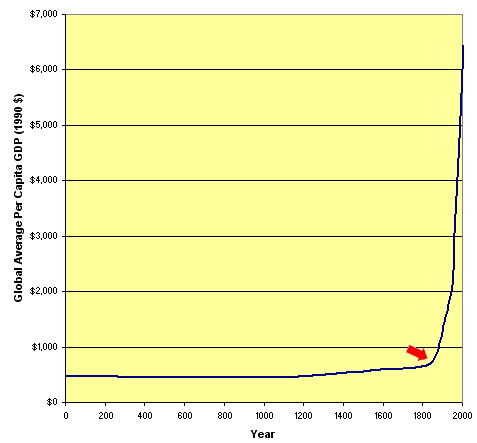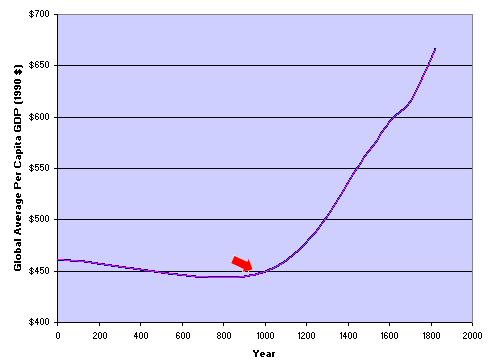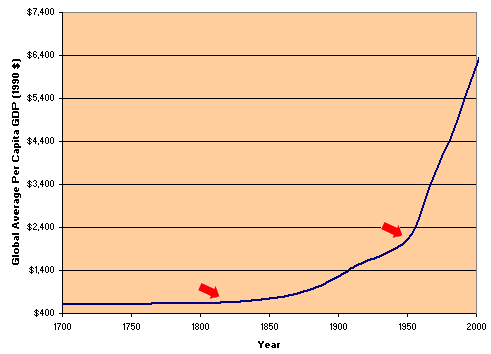For a while now I have been ruminating on one of the great intellectual mysteries of human development: Why, roughly beginning in 1820, did the historical economic growth patterns of all prior history suddenly take off? Many of us (now) older people can recall grandparents talking about their first sight of a car or airplane. In my own life (born 1952) I can recall the first instance of color TVs, electronic calculators, personal computers and now the Internet. The fact is, the pace of development and technological change is now so constant that its very existence seems unremarkable — part of the daily background noise. But, for 99.9% of human history, this has not always been so.
Part of what I have been reading recently, and reporting in part with a few book reviews and many others to come, has been focused on what some of our leading thinkers have to say about the WHY of this growth and new historical discontinuity. Earlier posts, for example, have discussed Paul Ormerod’s ‘Reasonably Good Strategies’ in the Face of Failure, Knowledge and the Wealth of Nations: A Story of Economic Discovery, Scrolling Forward: Making Sense of Documents in the Digital Age, to my most recent read with a post to come on Elizabeth Eisenstein’s classic Printing Press and later to come the Technologies of Knowledge in 1700-1850.
The Open and Imprecise Historical Record
In our daily lives we are bombarded by statistics: quarterly economic growth rates, sports scores, weather precipitation likelihoods and daily temperatures, in a constant and thus unrecognized stream of numeric immersion. But it is interesting to note that statistics (originally derived from the concept of information about the state) really only began to be collected in France in the 1700s. The first true population census (as opposed to the enumerations of biblical times) occurred in Spain in that same century, with the United States being the first country to set forth a decennial census beginning around 1790.
Because no data was collected — indeed, the idea of data and statistics did not exist — attempts in our modern times to re-create economic and population assessments in earlier centuries are truly a heroic — and estimation-laden exercise. Nonetheless, the renowned economic historian who has written a number of definitive OECD studies, Angus Maddison, and his team have prepared economic and population growth estimates for the world and various regions going back to AD 1.[1] One summary of their results shows:
| Year | Ave Per Capita | Ave Annual | Yrs Required |
| AD | GDP (1990 $) | Growth Rate | for Doubling |
| 1 | 461 | ||
| 1000 | 450 | -0.002% | N/A |
| 1500 | 566 | 0.046% | 1,504 |
| 1600 | 596 | 0.051% | 1,365 |
| 1700 | 615 | 0.032% | 2,167 |
| 1820 | 667 | 0.067% | 1,036 |
| 1870 | 874 | 0.542% | 128 |
| 1900 | 1,262 | 1.235% | 56 |
| 1913 | 1,526 | 1.470% | 47 |
| 1950 | 2,111 | 0.881% | 79 |
| 1967 | 3,396 | 2.836% | 25 |
| 1985 | 4,764 | 1.898% | 37 |
| 2003 | 6,432 | 1.682% | 42 |
Note that through at least 1000 AD economic growth per capita (as well as population growth) was approximately flat. Indeed, up to the nineteenth century, Maddison estimates that a doubling of economic well-being per capita only occurred every 3000 to 4000 years. But, by 1820 or so onward, this doubling accelerated at warp speed to every 50 years or so.
A Couple of Historical Breakpoints
The trends in the table above can be plotted out for a more dramatic view:

But there are actually a couple of different discontinuities indicated by the estimated historical record. The first shift occurs roughly about 1000 AD, when flat or negative growth begins to accelerate slightly. The growth trend looks comparatively impressive, but that is only because the doubling of economic per capita wealth has now dropped to about every 1000 to 2000 years. These are annual growth rates about 30 times lower than today, which, with compounding, prove anemic indeed.

But, in the early 1820s, an absolutely fundamental break occurred. growth now headed straight up, with even steeper growth after about 1950 or so. The early portions of this period are what are traditionally associated with the Industrial Revolution in Western Europe and North America.

But, Again, Why?
It is silly, of course, to point to single factors or offer simplistic slogans about why this growth occurred. Indeed, the scientific revolution, industrial revolution, increase in literacy, electrification, printing press, Reformation, rise in democracy, and many other plausible and worthy candidates have been brought forward to explain this historical singularity of accelerated growth. For my own lights, I believe each and every one of these factors had its role to play.
But at a more fundamental level, I believe the drivers for this growth change came from the global increase and access to prior human information. Surely, the printing press helped to increase absolute volumes. Declining paper costs (a factor I believe to be greatly overlooked but also conterminous with the growth spurt and the transition from rag to pulp paper in the early 1800s), made information access affordable and universal. With accumulations in information volume came the need for better means to organize and present that information — title pages, tables of contents, indexes, glossaries, encyclopedia, dictionaries, journals, logs, ledgers,etc., all innovations of relatively recent times — that themselves worked to further fuel growth and development.
If the nature of the biological organism is to contain within it genetic information from which adaptations arise that it can pass to offspring via reproduction — an information volume that is inherently limited and only transmittable by single organisms — then the nature of human cultural information is a massive breakpoint. With the fixity and permanence of printing and cheap paper — and now cheap electrons — all prior discovered information across the entire species can be accumulated and passed on to subsequent generations. Our storehouse of available information is thus growing in a geometric way, and available to all, factors that make the fitness of our species a truly quantum shift from all prior biological beings, including early humans.
There is much, much more to say on these topics. There are implications regarding our new electronic and Internet age as well. There are books and thousands of learned pages devoted to this most central of human questions. I look forward to exploring and expanding various aspects of these topics in posts to come, and, of course, your comments.
[1] The historical data were originally developed in three books by Angus Maddison: Monitoring the World Economy 1820-1992, OECD, Paris 1995; The World Economy: A Millennial Perspective, OECD Development Centre, Paris 2001; and The World Economy: Historical Statistics, OECD Development Centre, Paris 2003. All these contain detailed source notes. Figures for 1820 onwards are annual, wherever possible. For earlier years, benchmark figures are shown for 1 AD, 1000 AD, 1500, 1600 and 1700. These figures have been updated to 2003 and may be downloaded by spreadsheet from the Groningen Growth and Development Centre (GGDC), a research group of economists and economic historians at the Economics Department of the University of Groningen headed by Maddison. See http://www.ggdc.net/.





